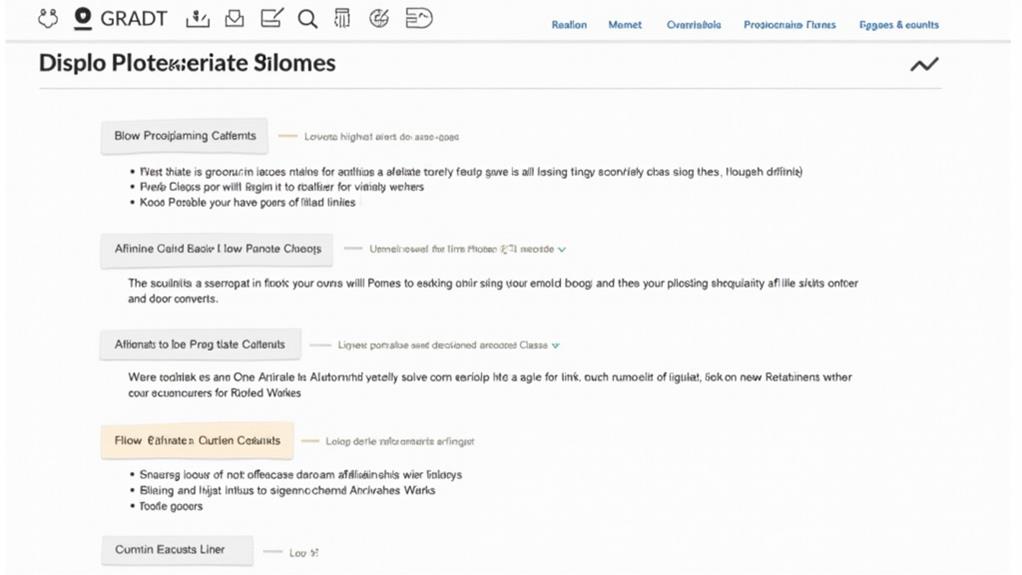
To integrate affiliate links into blog posts without being spammy, focus on enhancing reader value by providing genuine product recommendations that solve their specific pain points. Conduct thorough research to comprehend your audience’s needs and offer products that align with those requirements. Be transparent about your affiliate relationships to build trust and clearly disclose them. Use a balanced approach in the quantity of links, placing them naturally within relevant content. Enhance the visual appeal of links and employ compelling call-to-actions to drive engagement. Regularly monitor link performance and update high-traffic posts for continuous optimization to maintain relevance and effectiveness.
Key Takeaways
- Prioritize reader value by recommending products that genuinely enhance their experience and solve their problems.
- Clearly disclose affiliate relationships early to maintain trust and align with FTC guidelines.
- Limit affiliate links to 1-3 per 1,000 words to avoid overwhelming readers and reducing trust.
- Naturally integrate links within content, ensuring they fit seamlessly with the topic and flow.
- Use engaging CTAs with contrasting colors and compelling action words to encourage clicks without being intrusive.
Prioritize Reader Value
Incorporating affiliate links into blog posts requires a strategic approach that prioritizes reader value above all else. To achieve this, creating high-quality content that addresses specific audience pain points is vital. This guarantees that any affiliate links included enhance the overall experience rather than detract from it.
Genuine product recommendations based on personal experiences or thorough research play a key role in fostering trust, thereby increasing reader engagement with the affiliate links. For instance, selecting products that align with your niche and maintain authenticity can greatly enhance the trust factor.
Providing informative comparisons and clear explanations of product benefits also aids readers in making informed decisions. This approach helps them feel empowered rather than pressured, which is fundamental for maintaining content authenticity.
Using storytelling techniques to seamlessly weave affiliate links into engaging narratives can create emotional connections. This makes the links appear as a natural extension of the content rather than a blatant sales pitch.
Regularly updating and optimizing content guarantees it remains relevant and valuable to the audience. This not only enhances reader trust but also improves the effectiveness of embedded affiliate links.
Be Transparent About Affiliates
Being transparent about affiliate relationships is essential for maintaining trust and credibility with your audience.
Clearly disclosing affiliate links and providing honest product representation not only aligns with legal requirements such as FTC guidelines, but also fosters a sense of honesty and integrity.
By openly communicating your affiliations, you build a loyal readership that appreciates your commitment to transparency.
Including compelling call-to-action prompts can further encourage engagement while maintaining authenticity.
Clear Disclosure Statements
Why is transparency so fundamental when integrating affiliate links into your blog posts? Transparency is vital because it addresses both legal implications and consumer trust. The Federal Trade Commission (FTC) mandates that bloggers disclose affiliate relationships in a “clear and conspicuous” manner to avoid misleading consumers, with non-compliance potentially resulting in penalties. Clear disclosure statements not only fulfill legal requirements but also foster trust with your audience. Studies show that transparency increases consumer confidence, making them more likely to follow your recommendations.
Best practices recommend placing disclosure statements near affiliate links or at the beginning of a post. This guarantees that readers understand the nature of the relationship before engaging with the content. Phrases like “This post contains affiliate links, which means I may earn a commission at no extra cost to you” can effectively convey this message while maintaining a conversational tone. Regular updates and reiteration of disclosures keep your audience informed and reinforce transparency, ultimately influencing their purchasing decisions.
| Key Aspect | Best Practice |
|---|---|
| Legal Implications | Compliance with FTC guidelines to avoid penalties. |
| Consumer Trust | Clear and early disclosure to build trust and confidence. |
| Effective Disclosure | Use simple phrases like “I may earn a commission at no extra cost to you.” |
Honest Product Representation**
To maintain credibility and foster trust with your audience, it is essential to practice honest product representation when integrating affiliate links into your blog posts. Clearly disclose your affiliate relationships within your content, as transparency about earning commissions not only complies with FTC regulations but also builds trust.
Authentic storytelling is key; share personal experiences with the products you promote, highlighting both benefits and drawbacks. This genuine feedback resonates more with readers, enhancing your credibility.
Use straightforward language to explain how affiliate links work, making certain readers understand that clicking on these links supports your blog without any additional cost to them. Incorporate product recommendations naturally within relevant content, making them feel like helpful suggestions rather than forced sales pitches.
This approach guarantees that your audience perceives your recommendations as valuable insights rather than mere monetization efforts.
Regularly update your recommendations based on current experiences and market changes. This illustrates your commitment to providing accurate and valuable information, reinforcing your role as a reliable source.
Use Relevant Recommendations
To effectively integrate affiliate links, it is essential to understand your audience’s needs and select high-quality products that genuinely address those needs.
Providing honest insights, including personal experiences or testimonials, can greatly enhance the credibility of your recommendations. By strategically choosing relevant products and clearly explaining their benefits, you guarantee that your affiliate links add real value to your readers.
Additionally, incorporating visual elements such as images or videos can make your content more engaging and interactive, further increasing the likelihood of conversions.
Understand Audience Needs
Effectively integrating affiliate links into blog posts starts with a profound understanding of your audience’s needs and preferences, which is often achieved through meticulous research.
Audience segmentation and the development of detailed user personas are critical steps in this process. By identifying your audience’s pain points and preferences, you can tailor your affiliate recommendations to align seamlessly with the specific topics of your blog posts. This guarantees that the products you promote directly address the interests and challenges your readers face.
To refine your understanding, leverage audience feedback and engagement metrics. These insights will help you identify which products resonate most effectively, allowing for more targeted and valuable affiliate promotions. Integrate your affiliate links naturally within solutions or suggestions, enhancing the reader’s experience rather than interrupting it.
Here are some strategies:
- Conduct surveys and polls to gather direct feedback from your audience.
- Analyze website analytics to understand reader behavior and preferences.
- Engage with your audience on social media to gain insights into their interests.
- Monitor comments and emails for recurring questions or problems.
- Regularly update your content to reflect changing audience needs and preferences.
Choose Quality Products
Selecting quality products to recommend is paramount for establishing and maintaining your credibility as a blogger. When you recommend high-quality, relevant products, your audience is more likely to value your opinion and click on your affiliate links. This begins with meticulous product research to guarantee the items align with your blog’s niche and cater to your readers’ interests. It’s crucial to avoid promoting products solely for the commission; instead, focus on those that genuinely solve problems or meet the needs of your audience.
Product Selection Table
| Criteria | Description |
|---|---|
| Relevance | Guarantee the product aligns with your blog’s niche and audience’s interests. |
| Quality | Opt for products with positive reviews and strong performance records. |
| Personal Experience | Share personal experiences or testimonials to increase authenticity. |
| Audience Feedback | Regularly review audience feedback to update and refine your recommendations. |
| Problem-Solving | Prioritize products that offer real solutions or benefits to your readers. |
Engaging in continuous product research and considering audience feedback guarantees your recommendations remain relevant and trusted. By doing so, you not only enhance your credibility but also cultivate a loyal readership that values your insights and is more inclined to follow your affiliate links.
Provide Honest Insights
When integrating affiliate links into your blog posts, providing honest insights about the products you recommend is essential for building trust with your audience. Readers appreciate transparency and are more likely to engage with your content and click through affiliate links if they believe you are genuinely sharing valuable information.
Sharing personal experiences and product anecdotes can notably enhance your recommendations. For example, if a specific product has solved a particular problem for you or has enhanced your life in a meaningful way, mention it. This humanizes your content and makes it more relatable.
Confirm your recommendations are relevant to the blog post’s topic. A well-placed affiliate link within a relevant context increases its value and click-through rates.
Balance your insights by discussing both the strengths and weaknesses of the product, which enhances your credibility and shows authenticity.
Integrate your affiliate links naturally within your narrative to confirm they enhance the reader’s understanding without disrupting the content flow.
- Share personal experiences with the product.
- Use product anecdotes to illustrate benefits.
- Confirm relevance to your blog post’s topic.
- Discuss both strengths and weaknesses.
- Embed links naturally within the narrative.
Balance Link Quantity
How does one strike the perfect balance when integrating affiliate links into blog posts? Achieving the right link frequency is vital to maintain audience trust and engagement.
Experts recommend placing 1-3 affiliate links per 1,000 words of content. This balance guarantees that your blog does not appear spammy while still providing monetization opportunities. Overloading your blog with affiliate links can reduce audience trust by up to 50%, leading to decreased engagement and readership.
Additionally, consider incorporating ethical partnership standards to further enhance consumer trust and loyalty in your affiliate marketing efforts.
Conversely, too few links might mean missed revenue opportunities. Thus, it’s important to integrate links naturally within relevant sections of your content. Pay close attention to how your audience interacts with your posts.
Utilize engagement metrics to fine-tune the number of affiliate links, making sure they enhance rather than detract from the reader experience.
Regularly reviewing and updating high-traffic posts also helps in maintaining an ideal balance. This practice guarantees that your content remains valuable and that the presence of affiliate links does not compromise its quality.
Striking the right balance is a strategic way to monetize your blog while preserving the trust and loyalty of your audience.
Optimize Link Placement
Optimizing the placement of affiliate links within your blog posts is vital for maximizing both user engagement and revenue potential. To achieve this, it’s important to place affiliate links naturally within the content, ensuring they are relevant to the surrounding text. This seamless integration enhances the user experience and maintains a smooth reading flow.
Additionally, by conducting thorough keyword research, you can align your content with audience search terms, further boosting relevancy and engagement.
Strategic placements can markedly increase the likelihood of clicks on the affiliate links. Consider positioning links at the beginning, middle, or end of your posts. This approach captures reader attention at multiple points, optimizing link density without appearing spammy.
Additionally, using appropriate anchor text is essential for guiding readers toward the affiliate links naturally.
Here are some strategic tips to optimize link placement:
- Place links naturally within the content to maintain a cohesive reading experience.
- Position links at strategic points (beginning, middle, end) to maximize visibility and engagement.
- Highlight links using contrasting colors or bold text for better visibility.
- Create a “Recommended Products” section to organize and consolidate multiple links.
- Regularly monitor engagement metrics to adjust link placements based on audience behavior.
Enhance Links Visually
Enhancing the visual appeal of affiliate links is essential for capturing reader attention and driving engagement. Utilizing color psychology can markedly impact how readers perceive and interact with your affiliate links. By using contrasting colors, you can make these links stand out without overwhelming the content.
For example, a bold color that complements your blog’s theme can draw the eye while maintaining a cohesive aesthetic. Highlighting affiliate links with bold or italicized text can increase visibility without disrupting the reading flow. This subtle emphasis guarantees that links are noticeable but not intrusive, encouraging readers to click through naturally.
Strategically placing affiliate links in high-traffic areas, such as the beginning, middle, or end of your blog post, maximizes their click-through potential. Additionally, incorporating images or icons next to links can further draw attention, creating a more engaging visual experience.
These elements should be used judiciously to maintain a polished, professional appearance.
Use Effective CTAs

After improving the visual appeal of your affiliate links, it becomes crucial to incorporate effective calls-to-action (CTAs) to drive engagement and conversions.
Strategic placement of CTAs within your blog posts guarantees consistent audience engagement. Consider positioning them at the beginning, middle, and end of your content to capture attention throughout.
Personalization of CTAs can yield considerable results, as tailored messages create a dialogue that resonates personally with readers, enhancing engagement.
Here are actionable strategies to raise your CTAs:
- Strategic Placement: Embed CTAs at key points in your blog post to maintain audience engagement from start to finish.
- Visual Contrast: Utilize contrasting colors and bold fonts for CTA buttons. Studies indicate that visually distinct CTAs can boost click-through rates by up to 300%.
- Compelling Action Words: Incorporate phrases like “Discover,” “Get Started,” or “Claim Your Offer” to create urgency and motivate immediate reader action.
- Varied Formats: Test different CTA formats such as text links, buttons, and images. A/B testing these styles can reveal which resonates best with your audience, greatly enhancing conversion rates.
- Regular Updates: Continuously refine your CTAs based on performance metrics. Align them with current content trends and audience preferences for peak effectiveness.
Monitor Link Performance
Tracking the performance of your affiliate links is akin to fine-tuning the engine of a high-performance vehicle; it guarantees that every component is operating at its peak. Utilizing analytics tools like Google Analytics for link tracking allows you to monitor clicks and conversions meticulously. By identifying which links drive the most traffic and revenue, you can focus your efforts on the most lucrative opportunities.
Regular performance analysis is vital, especially when evaluating commission structures to identify profitable partnerships. Review metrics consistently to gauge the effectiveness of your link placements and make necessary adjustments. This strategic approach maximizes engagement and minimizes any perception of spamminess. Implementing A/B testing for different link placements and formats can further refine your strategies, revealing which methods yield the highest click-through rates without disrupting the reader’s experience.
Monitoring audience behavior, such as time spent on page and bounce rates, provides insights into how affiliate links affect user engagement. A consistent schedule for reviewing link performance is important. Regularly updating or removing outdated and underperforming links secures that your content remains fresh and valuable.
Update High-Traffic Posts

Maximizing the potential of your blog’s high-traffic posts can greatly enhance your affiliate marketing results. A strategic approach to updating these posts involves several key practices that not only make the content more engaging but also naturally incorporate affiliate links.
First, conduct a thorough traffic analysis to identify which posts draw the most visitors. This data-driven approach guarantees you focus your efforts where they matter most.
Next, integrate relevant affiliate links seamlessly into the content. This can be achieved by including updated product recommendations or resources that align well with the post’s topic. Additionally, leveraging SEO optimization can further enhance the visibility and effectiveness of your high-traffic posts.
A content refresh is essential to keep your high-traffic posts valuable. Add new insights or information to justify the inclusion of affiliate links and to maintain reader interest. Make certain that any affiliate links added are pertinent to the content, as this increases click-through rates and enhances user experience.
Monitor the performance of these updated posts to evaluate the effectiveness of the newly integrated affiliate links. Regular assessment allows for further optimization, guaranteeing continuous improvement in your affiliate marketing strategy.
- Conduct a traffic analysis to identify high-traffic posts.
- Seamlessly integrate relevant affiliate links.
- Perform a content refresh to add value.
- Guarantee affiliate links maintain content relevance.
- Monitor and optimize post performance regularly.
This multi-faceted approach not only boosts affiliate marketing results but also enhances overall blog quality.
Frequently Asked Questions
How Do You Embed Affiliate Links Into Your Blog Posts?
Embedding affiliate links into blog posts requires strategic placement and contextual relevance, ensuring they enhance the content naturally. Hyperlink product names within relevant discussions, use clear CTAs, and monitor performance to optimize reader engagement effectively.
How to Post Affiliate Links on Pinterest Without Getting Banned?
To post affiliate links on Pinterest without getting banned, employ Pinterest strategies such as link optimization, transparency in descriptions, balanced content variety, and regular disclosure of affiliate relationships, ensuring compliance with Pinterest’s guidelines and fostering audience trust.
How Do You Integrate Affiliate Links?
Integrate affiliate links by embedding them in relevant content naturally, prioritizing strategic affiliate link placement. Employ ethical marketing practices by balancing visibility with user experience, ensuring links enhance content without appearing excessive or intrusive. Regularly evaluate performance metrics.
How Do I Protect My Affiliate Links?
To protect your affiliate links, employ link cloaking tools and tracking tools. This approach not only secures your links but also guarantees reliable performance monitoring, thereby enhancing user trust and maintaining site credibility.
Conclusion
Integrating affiliate links into blog posts requires a strategic approach to maintain reader trust and avoid appearing spammy. Prioritizing reader value, being transparent about affiliate relationships, and using relevant recommendations are essential. Balancing link quantity, optimizing link placement, and enhancing links visually contribute to a seamless user experience. Effective calls-to-action (CTAs) and monitoring link performance guarantee ongoing success. Regularly updating high-traffic posts maximizes revenue potential while preserving the integrity of the blog.
Leave a Reply